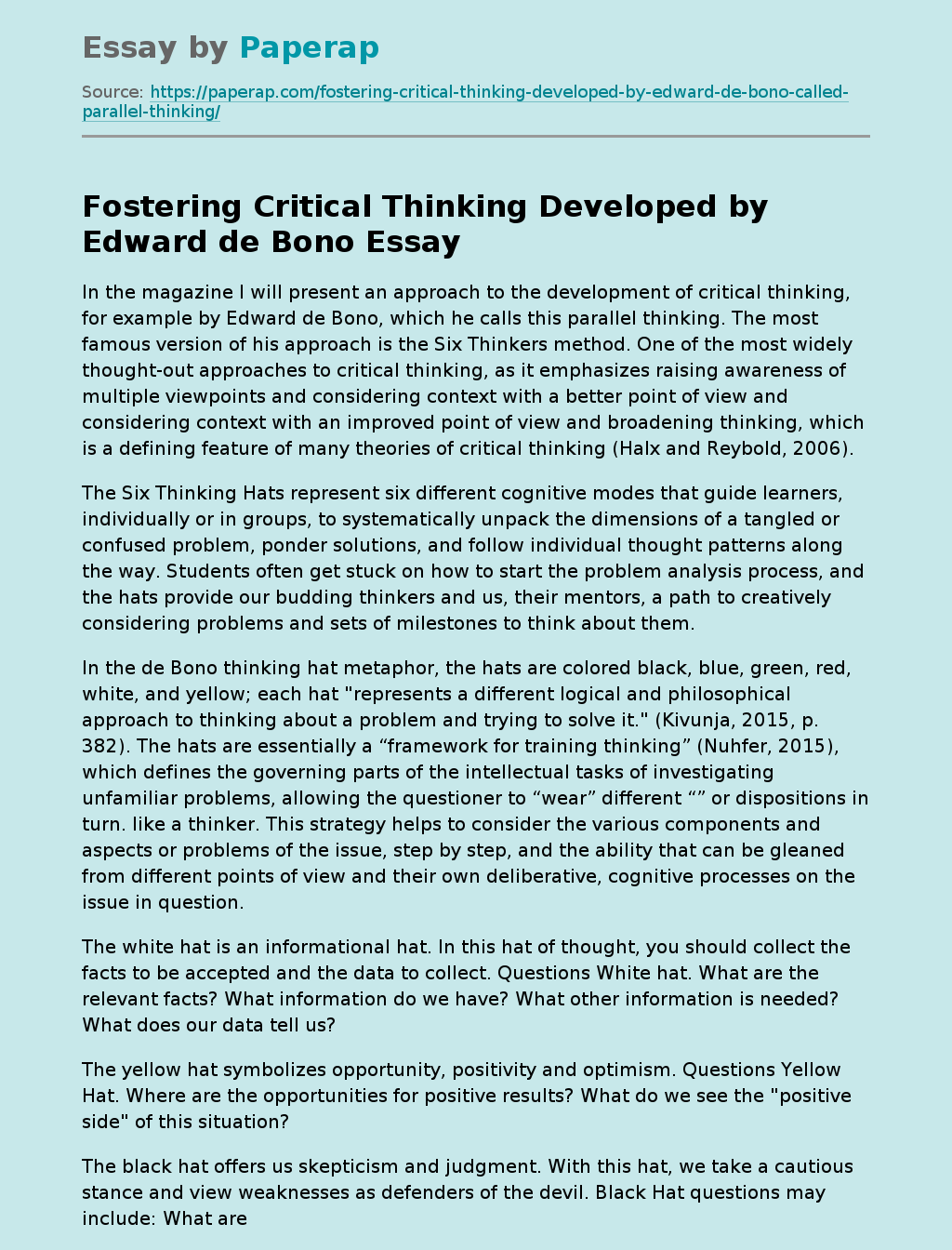Fostering Critical Thinking Developed by Edward de Bono
In the magazine I will present an approach to the development of critical thinking, for example by Edward de Bono, which he calls this parallel thinking. The most famous version of his approach is the Six Thinkers method. One of the most widely thought-out approaches to critical thinking, as it emphasizes raising awareness of multiple viewpoints and considering context with a better point of view and considering context with an improved point of view and broadening thinking, which is a defining feature of many theories of critical thinking (Halx and Reybold, 2006).
The Six Thinking Hats represent six different cognitive modes that guide learners, individually or in groups, to systematically unpack the dimensions of a tangled or confused problem, ponder solutions, and follow individual thought patterns along the way. Students often get stuck on how to start the problem analysis process, and the hats provide our budding thinkers and us, their mentors, a path to creatively considering problems and sets of milestones to think about them.
In the de Bono thinking hat metaphor, the hats are colored black, blue, green, red, white, and yellow; each hat “represents a different logical and philosophical approach to thinking about a problem and trying to solve it.” (Kivunja, 2015, p. 382). The hats are essentially a “framework for training thinking” (Nuhfer, 2015), which defines the governing parts of the intellectual tasks of investigating unfamiliar problems, allowing the questioner to “wear” different “” or dispositions in turn. like a thinker. This strategy helps to consider the various components and aspects or problems of the issue, step by step, and the ability that can be gleaned from different points of view and their own deliberative, cognitive processes on the issue in question.
The white hat is an informational hat. In this hat of thought, you should collect the facts to be accepted and the data to collect. Questions White hat. What are the relevant facts? What information do we have? What other information is needed? What does our data tell us?
The yellow hat symbolizes opportunity, positivity and optimism. Questions Yellow Hat. Where are the opportunities for positive results? What do we see the “positive side” of this situation?
The black hat offers us skepticism and judgment. With this hat, we take a cautious stance and view weaknesses as defenders of the devil. Black Hat questions may include: What are the difficulties? Where are the cons? What could go wrong?
The Red Hat is a hat of the senses that evokes emotion and intuition. Red Hat questions may include: What do we like about this and why? What do we dislike and why? How can our gut reaction influence our thinking? The Green Hat perspective focuses on creativity, new ideas, and thinking outside the box. Green Hat questions can include: What creative options are there? What alternatives have we not considered? How can brainstorming help us here?
Exercises
Six Thinking Hats: Group Discussion
Distribute to students the Six Hats handout with questions that prompt thought in each area. Arrange the students in a large circle and alternately throw a hat of one of the six colors in the center. Students in a group discuss problems in the manner of their hat. This process continues until the group has an opportunity to discuss a topic with each of the six types that are periodically tossed into the center. A recorder on a whiteboard or flip chart records the contribution of the role play. After the role play, offer a follow-up, such as a reflexive task in which you ask students to write down what they have learned from the discussion and share their thoughts in the ensuing group discussion.
Six Thinking Hats: Problem Analysis
Ask or have students pick a problem from the “real world” to ponder using hats — it could be a headline problem, a student-centered problem as defined in their school, or a personal problem as each individual defines. analysis. Working individually or in groups of users, students systematically solve problems using the thinking of each group, and record their answers in writing.
Encourage students to use the Blue Hat in a persistent metacognitive monitor, devoting sufficient time and effort to each step, noticing which hats are illuminating others and the methods that challenge or inspire them in the process. Then ask students to discuss their experiences with peers using one-to-one or group presentations.
Сonclusions
We believe Hats are a useful heuristic for educators looking for an effective and simple method to help students critically and broadly think about new and familiar problems. Hats promote deep and stable thinking through a deliberately structured but open mind switching methodology (de Bono, 1999, p. 14). By opening multiple lenses to view a problem and responding impartially to creative exploration with the participation of others, our students can find new paths on their way to thoughtful critical thinking and flexible problem solving.
Fostering Critical Thinking Developed by Edward de Bono. (2021, Feb 10). Retrieved from https://paperap.com/fostering-critical-thinking-developed-by-edward-de-bono-called-parallel-thinking/

